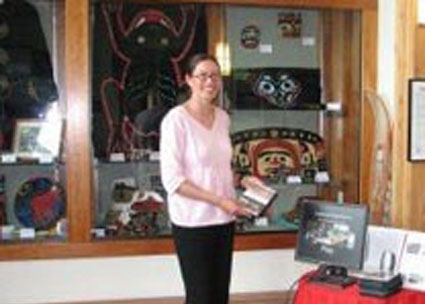Grant Spotlight | November 15, 2013
Share This |
Grantee: Chilkoot Indian Association
Grant: 2009 Native American Library Service Enhancement Grant Pictured: Jolanta Ryan, former education coordinator for the Haines Borough Public Library, stands in front of a display of Tlingit artwork on loan from community members. |
Contact: Patricia Brown |
It feels like our culture is coming back to life.
-Tlingit Tribal Elder
Haines Borough is a remote Alaskan community that was hard hit by the economic recession. Haines Borough Public Library and the Chilkoot Indian Association had been working together for about eight years to help the community. The association developed a strategic plan that included improving library services and collections to highlight the local culture and traditions while continuing to build technical literacy across the community. With funding from IMLS, the partners launched the Chilkat Valley Fingerprints Project.
The library’s new cultural education programs were designed to harness the power of traditional skills and knowledge to preserve traditions and improve the economic outlook for families and the community.. These monthly cultural programs have proven enormously popular and continue to share information across the community, focusing on subjects such as the history of the native people and traditional foods, art, and music. Tlingit tribal elders tell traditional stories, beginning their narratives in Tlingit before switching to English. They also share practical information, such as methods of sustainable fishing and of preparing traditional foods that are healthy and economical. One initiative led to the development of a community garden that now yields fresh produce for the school lunch program.
The Fingerprints Project included two documentary films produced by a former Haines student, now a graduate of the San Francisco Art Institute, who had participated in and gained production skills from the library’s Film Club. The Chilkoot Trade Routes: A Tlingit Tradition combines historical photographs with narration by tribal elders to preserve and share the area’s rich history of hunting, crafts, and trade activities. The Yendistucky Cemetery, A Restoration of History captures how the community came together to clean and restore an almost-forgotten tribal cemetery, rescuing a historic site in danger of deteriorating beyond salvation. Highlights of the films are shared online, and each documentary is available on loan from the Alaska State Library, and sold through Friends of the Library.
The library regularly sponsors a series of technology education programs for residents of all ages, helping elders, adults, youths, and children gain technical literacy and proficiency. One particularly popular technology initiative is the new Chilkat Valley Storyboard that was developed with help from a 2011 IMLS grant. The storyboard, which is on a Microsoft Surface®table at the library, is an interactive regional map with an enhanced touch screen. When users touch one of 40 “place marks” on the map, they are connected to traditional place names and cultural history, with video, audio, and other multimedia content.
In the course of developing the programs, the association and library created and enhanced ten new partnerships. Key collaborators include the Sheldon Museum and Cultural Center, the Chilkoot Watershed Council, the Takshanuk Watershed Council, the Jilkaat Kwaan Heritage Center, the Chilkat Valley Community Foundation, the Haines Borough School District, and the Southeast Alaska Regional Health Consortium. These strong partnerships reflect the growing strength of the community they serve.
The project’s collaborative programs have had major impacts on quality of life in this sparsely populated, interdependent rural area. In the first year, the project began sponsoring community forums, called Community Matters, to discuss and decide what could be done to strengthen the overall community in Haines. Thirty-five people participated in first event, spurring ideas and conversations on how to reach across cultural and generational lines. Today, each Community Matters event draws ever-increasing crowds, resulting in better relationships and communication.
The Fingerprints Project has proved much greater than the sum of its programs. It has succeeded in bringing new education and services and greater technical literacy to the community. By sharing and preserving traditions, sponsoring dialog and consensus, and forging new connections, the project has also fostered new vitality and mutual understanding throughout a diverse community
